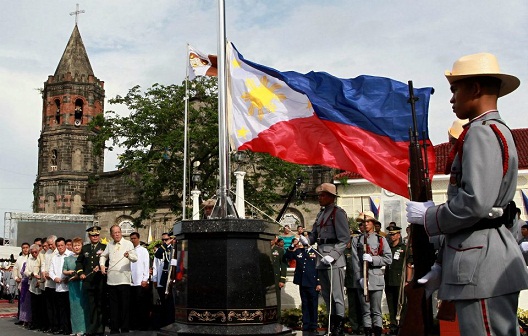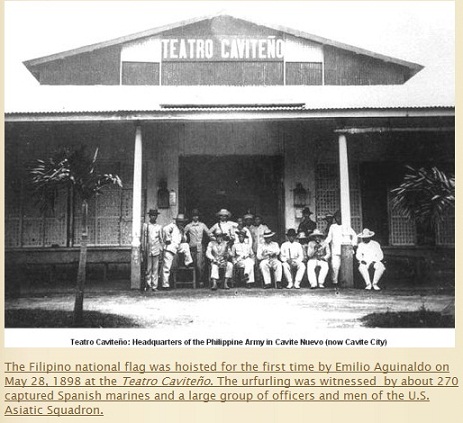
A friend who listened to President Aquino’s speech at the 114th Philippine Independence Day celebration at Barasoain Church in Malolos, Bulacan yesterday called me up confused about a historical event he cited.
The President started his speech recalling last year’s Independence Day celebration in Kawit, Cavite:
“Noon pong nakaraang taon, nagtipon tayo sa Kawit, Cavite, sa balkonahe ni Heneral Emilio Aguinaldo kung saan unang iwinagayway ang ating bandila. Doon, unang kumumpas ang martsang Lupang Hinirang, sabay sa pintig ng puso ng mga rebolusyunaryong Pilipinong, sa wakas, ay kalag na sa tanikala ng mga dayuhan. Doon, unang pinasinayaan ang karapatang makapamuhay nang malaya at nagsasarili ang bansang Pilipinas.”
The English translation: “A year ago, we gathered in Kawit, Cavite, on General Emilio Aguinaldo’s balcony, where our flag was first unfurled and waved. It was there where our national anthem, the Lupang Hinirang, was first played—its rhythm matching the pulsating hearts of Philippine revolutionaries, who were finally freed from the shackles of foreign rule. There, the Philippines claimed its right to be a free and independent nation.”
My friend said, “Aren’t we celebrating National Flag Day on May 28 because it was on May 28,1898, not June 12, 1898, when the Philippine flag was first unfurled?”
She also said she remembered her history that the Philippine flag was first unfurled in Cavite City, not in Kawit.
I tried to help her by doing online research and what I found made me also confused.
There was an article in the Philippine Daily Inquirer last May 28 on National Flag Day by Cielo R. Reyno, senior history researcher at the National Historical Commission of the Philippines.
A portion of that article said: “The nation is celebrating National Flag Day today (Monday), May 28.
“On this day in 1898, some of the 2,000 rifles and 200,000 rounds of ammunition that arrived at the Cavite port two days earlier were delivered to a little known revolutionary enclave, a barrio named Alapan, now part of Imus, Cavite.
“The Spaniards learned about the delivery and sent an infantry force of about 270 soldiers to the barrio to confiscate the weapons.
“But the local revolutionists put up a fight, engaging the Spaniards from 10 in the morning until 3 in the afternoon.
“The gun battle ended in victory for the Filipinos, who took their Spanish prisoners to the revolutionary headquarters in Cavite that same day.
“As they approached the headquarters to the shouts and cheers of the locals, Gen. Emilio Aguinaldo, leader of the Philippine Revolution, waved the Philippine flag that he had brought back with him from exile in Hong Kong.
“It was a moment of glory for the revolutionists and for the Filipino people. It was the eve of the birth of a new nation.”
I found another article by Arnaldo Dumindin on Philippine-American War, 1899-1902 which helped clarify the date of the unfurling of the flag for the first time because it distinguished the “unofficial” from the “official” act.

It stated:”The Aguinaldo mansion in Kawit, Cavite, site of the historic Proclamation of Philippine Independence on June 12, 1898 was declared a national shrine in June 1964. General Emilio Aguinaldo died on Feb. 6, 1964. The balcony did not exist in the 19th century; likewise, although he unfurled it, it wasn’t Aguinaldo who waved the Philippine flag from the central window; Ambrosio Rianzares Bautista did.
“On June 12, 1898, Emilio Aguinaldo declared the independence of the Filipinos and the birth of the Philippine Republic “under the protection of the mighty and humane North American Union.”
“This momentous event took place in Cavite el Viejo (“Old Cavite”, now Kawit), Cavite Province. Admiral Dewey had been invited but did not attend. The Filipino national flag was officially unfurled for the first time at 4:20 PM.
“ The same flag was actually unfurled, albeit unofficially, on May 28, 1898 at the Teatro Caviteño in Cavite Nuevo—now Cavite City—right after the battle of Alapan, Imus, Cavite, and again three days later over the Spanish barracks at Binakayan, Cavite, after the Filipinos scored another victory.”
I contacted historian Manolo Quezon,who is now undersecretary for Presidential Communications Development and Strategic Planning, and here’s his explanation by text message:
“ The independence day proclamation states it was first formally presented to the people there. What our flag days commemorate is its being used in battle May 28 hence flag days from date of battle to formal proclamation of independence on June 12 where flag and anthem first presented.
“Also for Filipinos at the time and to now, June 12 is the date hence Flag Day was June 12 since 1941 and the proclamation itself speaks of the flag formally being presented to the assembled people at Kawit.
“It’s only recently we shifted to Flag Days and not Flag Day marking continuum from display in battle to unfurling before the people: Flag Day was moved to June 12 in 1941 with Aguinaldo’s approval even before Independence Day was June 12.”
That’s our history lesson for today.
Here’s another version.
From Elmer Ordoñez:
Because of claims that the flag was first unfurled in Cavite City I did some googling and read an article (Manila Times, May 28, 2008) by Augusto de Viana, chief history researcher of the National Historical Institute, citing a pamphlet in Spanish by Aguinaldo that the first flag-waving took place near the port of Cavite Nuevo, not in Alapan.
The NHI researcher said that a “famous battle took place” in Alapan on May 28, but “no flag fluttered at the battle.” It was “the sight of the prisoners marching into the Cavite port that prompted Aguinaldo to bring out the flag made in Hongkong and to display it publicly.”
http://archives.manilatimes.net/national/2009/march/28/yehey/opinion/20090328opi2.html
Viana’s version is actually similar to Reyno’s mentioned in the article.
What place is correct? Kailangan mag-conference ang mga living historians, magkasundo sila sa tunay na lugar kung saan unang itinaas ang banderang Pinoy. Mali-mali ang natututunang nakaraan ng mga kabataan/mag-aaral.
Ano ba yan?! Pati mga historians iba iba ang pananaw. Ngeeeks!
One of this nation’s greatest weakness: the ability to document!
chijap #4, you can not blame them. Because during those days Steve Jobs has not yet been born.
Ayaw pumayag ng anak ko, pati siya naguguluhan. Kasi ang alam niya, si Bong Revilla ang unang nagwagayway sa bandila, sa Binakayan.
Seriously (or not), while Cielo Reyno claims
Arnaldo Dumindin asserts
This, despite Reyno’s claim that the confiscating team was engaged in a five-hour gun battle with the locals, it seems that nobody died in the long exchange, but all the 270 Spaniards apparently surrendered thereafter. Hahaha.
Tongue, alam mo naman dito sa atin. Madalas hinahaluan ng exageration sa mga kwento lalo na sa probinsya. Halimbawa: “Si Neneng hinalikan siya ng boypren niya”. Pag dating sa kabilang bayan: “Si Neneng, nabuntis ng boypren niya”. 😛
kapag sobrang talino ng mga tao, talagang hindi magkakasundo.
ang unang watawat ng pilipinas ay iwinagayway ni george estregan sa balkonahe ng kanilang bahay.
kung saan ‘yun, itanong ninyo kay miriam.
whaa!
# 7. It’s fun reading Philippine history.
Itong si Tongue at Magno talaga, hahahaha!
Yes, Ellen…almost everything in Pinas is fun. 🙂 I’m proud to be a Pinoy!
#7 I’ve seen this kind of encounter in old Tagalog movies on TV. Dami-daming kalaban, walang sugat ang bida. Kahit buhok hindi nagugulo.
The song conducted itself? Tao ang kumukumpas man, hindi tugtugin.
My rephrase:
Doon unang tinungtog ang himig na siyang naging ating Pambansang Awit; at nang maglaon, ay tinawag na Lupang Hinirang.
From wikipedia:
The tune was not called Lupang Hinirang. It was entitled Marcha Filipina Magdalo (naku, factionalism na naman). Later, it was called Marcha Nacional Filipina.
The first lyrics were Spanish, from the poem “Filipinas”, by Jose Palma. An English translation was penned by Camilo Osias, which became official in 1938. I’m sure JPE, Cuevas, Joker and Nene Pimentel remember singing
Land of the morning,
Child of the sun returning,
With fervor burning,
Thee do our souls adore.
in their youth.
There were several Tagalog versions, including one in the Japanese era. Lupang Hinirang only came about in 1958, and the version we know now is the revised version of 1960.
There is a Tagalog version of the late 60s, from my sixth grade buddies, part of which goes:
“Sa dagat at bundok maraming Huk, kasama si Taruc.”
# 12
Yes. And in war movies, the Japanese soldiers are shot always coming from behind a wall (left of the screen), running out of camera range (right of the screen). Ang dami nila. Then you notice that the same ten guys are coming from behind the wall running out of camera range. Umiikot lang pala behind the cameraman.
Tipid nga naman sa uniforms, and it gives the illusion of many soldiers.
And the grenade blasts, una pang tumatalon ang kalaban, before the blast.
Hahahaha. Filipinos are tops in creativity and resourcefulness.
We make up in creativity what we lack in financial resources.
Sumusobra lang paminsan-minsan :”And the grenade blasts, una pang tumatalon ang kalaban, before the blast.”
saxnviolins, you Tagalog is very good.
@jojo
Please. Jobs is not a great historian himself. He denied paternity to a daughter.